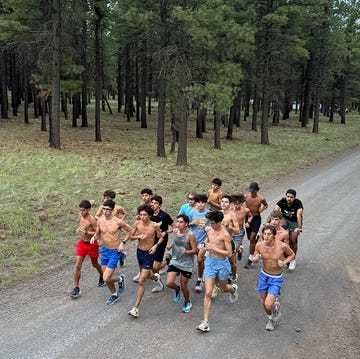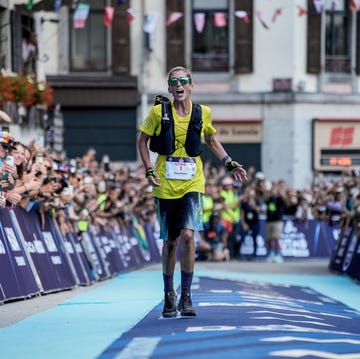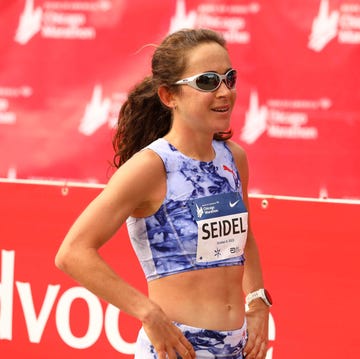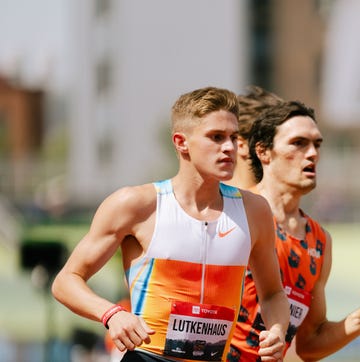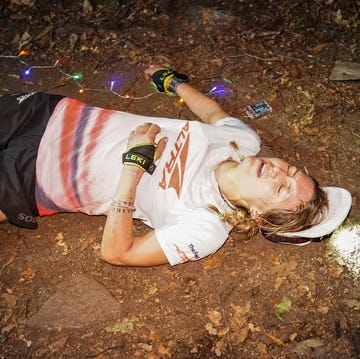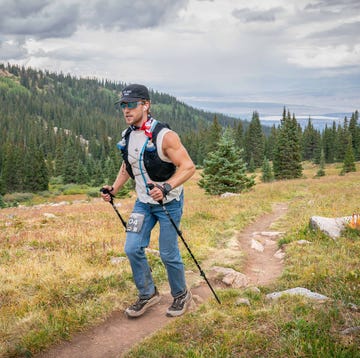After Noah Lyles became a professional athlete during the summer of 2016—straight out of high school—he was bored.
He and his younger brother, Josephus, both signed with Adidas and moved to the Orlando area to train with coach Lance Brauman. They were the new kids in the training group, only 19 and 18 years old, in a group of older athletes well-into their professional careers.
Free of the responsibilities of school, the brothers used their newfound free time to do what many teenagers do: hang out at the local mall.
“The mall here is separated into two portions,” Noah explains. “On one side, are all the normal stores … and then on the other side are all the luxury stores.” The brothers would often window-shop at the fancy boutiques, including AllSaints, a British high-fashion brand.
“I remember looking at one of the shirts and it was like $300,” he said. “And I was like, ‘Three hundred dollars for a T-shirt? Nah, I’m good … That was my first introduction to like, the next level of shopping.”
Turning expression into obsession
Soon, Lyles learned that fashion could be a way to express himself—and realized he had the money to do so. He started to customize his outfits to his mood, finding his style and building his wardrobe.
“If I want to be the punk-rock, gothic-vibe e-boy, I can find an outfit that has that vibe,” Lyles says. “If I want to be the super preppy kid, I have tons of those clothes. If I want to be the experimental, loose-gender-bending outfit, you know, I got all of those. Whatever I want to be in that moment or however I feel, that’s what I can throw on.”
Lyles’ interest in clothes has transformed into an integral part of his identity and value as an athlete. He has his own personal shoppers with direct connections to European fashion houses. He works with stylists to perfect his looks. In 2021, he was invited to the Met Gala. His outfits are loud, but elegant.
This year, Lyles has organized a series of pre-meet fashion-walks before some of the biggest meets in the world. But as large as Lyles’ pedigree is in track and field, he still feels like he’s waiting for the rest of the sport to catch on. His walk-ins, which he organizes along with his agent, Mark Wetmore, have only been “official” a few times. Many athletes, he says, are concerned about the lack of structure.
But with an increasing pressure for professional athletes to build their personal “brand,” more athletes are using their personal style to reach a wide audience.
A shifting tide
Gen Z loves a “fit check.” The rise of social media, particularly Instagram and TikTok have introduced a visual element to athletics that didn’t exist as prominently in other generations. A 2022 survey conducted by the Business of Fashion found that Americans in the 12 to 25 demographic “enjoy spending money on fashion [more] than any other entertainment category.” The generation ranked Instagram and TikTok as the two most important social media platforms for fashion inspiration.
Some athletes are realizing that fast times and medals aren’t enough to build a personal brand in track and field. Cooper Teare, the 23-year-old reigning national champion in the 1500 meters, thinks that a shift in culture has been occurring.
“I think it’s kind of like this exodus out of the old generation of track and field where it’s solely based on track and field,” he says. “Now we’re kind of blurring those lines and getting into the mainstream and seeing people actually have success and grow their brands because of the stuff they’re doing outside of the track.”
World Athletics, the international governing body of track and field, is beginning to recognize the influence of clothes on social media, too. This year, they’ve worked with Maya Bruney—the person behind the burgeoning Instagram account Track and Fits—to help showcase the outfits of the sport’s biggest stars.
An accomplished athlete herself (Bruney was the 2017 European junior champion in the 200 meters), the 25-year-old now solely focuses on content creation and growing her account. She photographs athletes before meets and posts them to the Track and Fits and World Athletics Instagram accounts, detailing which brands people are wearing. She also features them in her digital magazine, and the posts often have little to do with track and field itself.
“I don’t care about how you perform,” Bruney says. “I just care what you’re wearing.”
JuVaughn Harrison was the first athlete to grace the cover of Bruney’s magazine. At the Florence Diamond League meet in June, the 24-year-old Olympian in the long jump and high jump sported a Chrome Hearts T-shirt, matching Denim Tears x Bstroy denim jacket, and purple-and-white Amiri Skel sneakers.
“I always carry an outfit everywhere I go,” Harrison says. “That’s my one rule of thumb. I always have to have one outfit in my bag, just in case I have to go somewhere.”
Harrison says he enjoys the walk-ins, but he and others have recognized some logistical issues. For one, many track venues don’t have locker rooms, so some athletes are often relegated to changing into their competition attire in restroom stalls.
“Nobody wants to wear really nice clothes and go stand in a bathroom stall to take off your designer [clothes],” Harrison says.
Rethinking the traditional sponsorship model
Another hangup—or opportunity, depending on who you ask—are the sponsors. The top track and field athletes are generally funded by footwear companies, like Adidas (Lyles), Nike (Teare), and Puma (Harrison). Within these contracts, athletes are required to wear their sponsors’ apparel at meets and at many public appearances, but off the track, they have a bit more creative freedom.
As long as they aren’t wearing competing brands, athletes are generally free to express themselves, which Bruney believes is an asset. She says that cultivating an image outside of traditionally sports-related brands is crucial to personal brand building.
“I think as track athletes, we sometimes pigeonhole ourselves a little bit based on our performance,” Bruney says. “And so what happens if you get injured? What happens if you have a bad race? You have nothing to post [on social media].”
Brand collaborations are one way to straddle the line between sponsor obligations and personal style preferences. Companies like Nike and Adidas routinely partner with designer brands—like Gucci or Louis Vuitton—to reach multiple audiences.
Teare, who trains with the Bowerman Track Club, will sometimes wake up early to check out the latest Nike collabs through their elite athlete portal. He keeps a keen eye out for streetwear brands like Supreme and Stüssy. “When we’re up at altitude, and we’re just training, and the rest of the day is recovery, I just spend all day looking for that stuff,” he says.
Even jewelry can be an opportunity for new sponsorships since athletic brands generally don’t make similar products. At the U.S. Olympic Trials in 2021, hurdler Christina Clemons sported Doritos earrings during her races, which went viral. After she qualified for the Olympics, Doritos sent her a customized bag with her face on it and she became an official partner with the tortilla chip brand.
Getting everyone on board
Compared to the sprinters and jumpers who’ve successfully incorporated fashion into their personal brands, Teare believes that distance runners are lagging behind. One of the reasons, he says, is that distance runners tend to carefully measure their physical and mental energy ahead of a big race. So they might not be willing to devote time to showing off their outfits. “It’s hard to have fun with [your style] when you have 10,000 meters of running coming up,” he says.
Lyles recognizes that the sprinters and jumpers have been paving the way—but he’s open to anyone joining in on the fun. He and his agent are eager to work with governing bodies like USATF to make pre-race fashion walks an official part of meet programs. And he’s certainly open to including more distance runners.
“As soon as I know that somebody’s interested in it, I’m quickly ready to recruit,” he says. “Like as soon as somebody says, ‘Yeah, I have an interest in it.’ Cool, let me know. I’ll get you ready.”
Theo Kahler is the news editor at Runner’s World. He’s a former all-conference collegiate runner at Winthrop University, and he received his master’s degree in liberal arts studies from Wake Forest University, where he was a member of one of the top distance-running teams in the NCAA. Kahler has reported on the ground at major events such as the Paris Olympics, U.S. Olympic Trials, New York City Marathon, and Boston Marathon. He’s run 14:20 in the 5K, 1:05:36 in the half marathon, and enjoys spotting tracks from the sky on airplanes. (Look for colorful ovals around football fields.)







